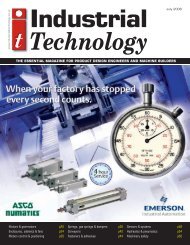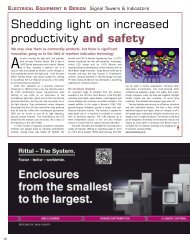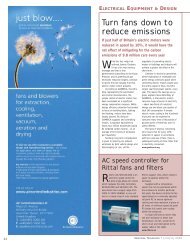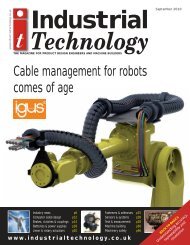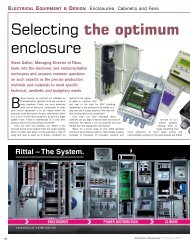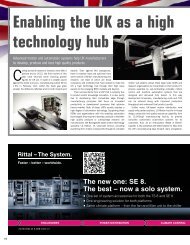sensors & systems - Industrial Technology Magazine
sensors & systems - Industrial Technology Magazine
sensors & systems - Industrial Technology Magazine
You also want an ePaper? Increase the reach of your titles
YUMPU automatically turns print PDFs into web optimized ePapers that Google loves.
Enclosures, Cabinets & Fans<br />
Warning<br />
safe in<br />
where wash down is essential for<br />
hygiene. Nylon and plated brass<br />
glands are suited for general industrial<br />
or marine applications.<br />
Most new developments are<br />
focused on speeding up the process of<br />
cable sealing and retention, offering<br />
push-fit glands and grommets in a<br />
range of designs. The main issue with<br />
these variations is that they provide<br />
limited mechanical grip and will only<br />
seal up to IP67. Because the retention<br />
material is soft, it is generally less<br />
resistant to extreme heat, but can be<br />
more resistant to corrosive<br />
atmospheres and liquids. They are not<br />
currently suitable for any Ex<br />
applications.<br />
Grommet options<br />
There are a number of membrane<br />
plug/grommet products available that<br />
offer good sealing up to IP67 that are<br />
very fast to use. As a grommet they<br />
are a push fit design both to install<br />
and to feed the cable through. Recent<br />
grommet designs will allow for a<br />
variety of cable and conductor widths.<br />
They are resistant to vibration and will<br />
provide for easy adjustment. They are<br />
not suitable for Ex applications or<br />
extreme heat and most don’t provide a<br />
great deal of cable retention force,<br />
unlike a clamped dome topped gland.<br />
There is a range of fast-fit<br />
grommet seals that clip into standard<br />
drilled and knockout holes that<br />
provide positive cable retention. The<br />
Klikseal from TST, for example, is<br />
moulded using two materials – a<br />
softer compound for the body/seal,<br />
and a stiffer inner material that<br />
applies positive clamping and cable<br />
retention. It will accommodate a few<br />
millimetres of wall thickness – self<br />
adjusting up to 5mm – and a range of<br />
cable diameters for each size. The<br />
added benefit of these designs is that<br />
they do not protrude far from the<br />
surface.<br />
Many contractors and OEMs are<br />
focused on reducing inventory and<br />
reducing overall line items, which is<br />
where these products really score. No<br />
tools are needed to fit them once there<br />
is a suitable aperture available, and<br />
the manufacturers claim they deliver a<br />
90% time saving.<br />
Enclosure manufacturers have<br />
also developed junction boxes that are<br />
manufactured using dual materials,<br />
injection moulding a softer compound<br />
into the wall design so that it forms<br />
self sealing cable entries. These will<br />
generally take a range of cable sizes<br />
providing sealing up to IP65 for a<br />
cable that is simply pushed through<br />
the flexible membrane. More suited to<br />
indoor applications or instances<br />
where there is secondary protection<br />
available such as a control cabinet,<br />
these junction boxes can certainly<br />
speed-up installation and assembly,<br />
particularly when the enclosures<br />
arrive onsite pre-populated with<br />
terminals and breakers.<br />
One such product is a junction box<br />
capable of connecting two or three<br />
round profile cables via an integral<br />
connector block that features a similar<br />
sealing method to the dome top<br />
gland. It is moulded in one piece and<br />
hinged so that the threaded sections<br />
of the cable entries fold together. The<br />
cables are then inserted through a<br />
seal and locking cap and the cap<br />
screwed into position to complete the<br />
assembly.<br />
In conclusion, the humble cable<br />
gland can be a boon when it is<br />
specified correctly, speeding-up<br />
production and installation time, and<br />
a liability if it is wrongly specified. The<br />
consequences of a water leak into a<br />
junction box can be catastrophic, not<br />
just for the internal components, but<br />
more importantly for the process,<br />
building or machinery that relies<br />
upon that connection.<br />
MORE INFORMATION:<br />
Enter D285 or visit ‘latest issue stories’ at<br />
www.industrialtechnology.co.uk for further<br />
details from Hylec Components<br />
all areas<br />
fans and blowers for extraction, cooling,<br />
ventilation, aeration, vaccum and drying<br />
• Curved forward bladed<br />
centrifugal fans<br />
• Flow rates up to 4500m 3 /hr<br />
(2600CFM)<br />
• Pressures upto 15mBar (6in.SWG)<br />
• Reliable and robust<br />
• ATEX versions<br />
• Many configurations and add-ons<br />
ACI’s single inlet centrifugal blowers offer<br />
quiet, powerful air delivery for localised air<br />
movement. Ideal for high velocity where<br />
space to fit a fan is at a premium.<br />
Please contact us for further detailed specifications and<br />
to discuss suitability for your application.<br />
www.aircontrolindustries.com<br />
the solution providers for air movement problems<br />
Air Control Industries Ltd<br />
Silver Street,<br />
T: +44(0)845 5000 501<br />
Chard,<br />
F: +44(0)845 5000 502<br />
Somerset,TA20 2AE, UK E: sales@aircontrolindustries.com<br />
May 2008 • INDUSTRIAL TECHNOLOGY<br />
More details: Write in 290 on the free information card<br />
29




